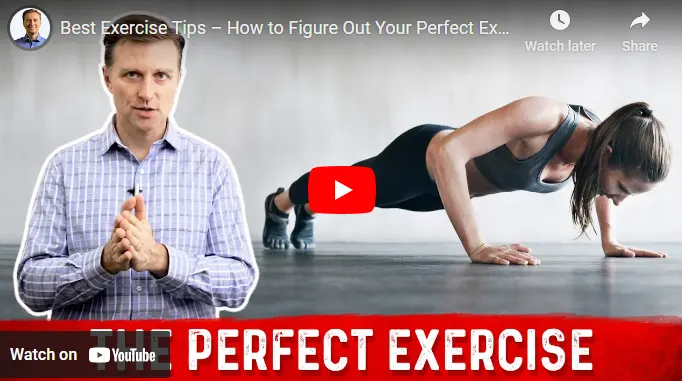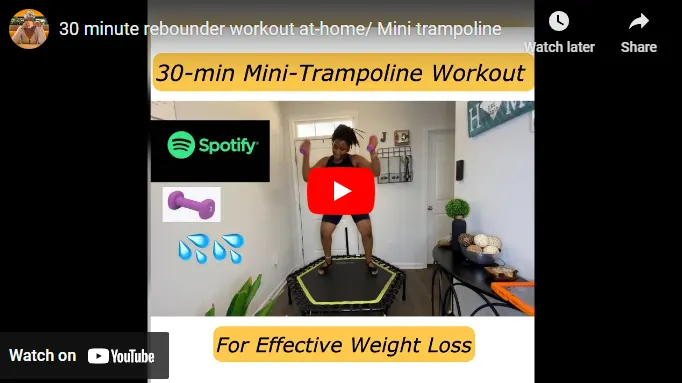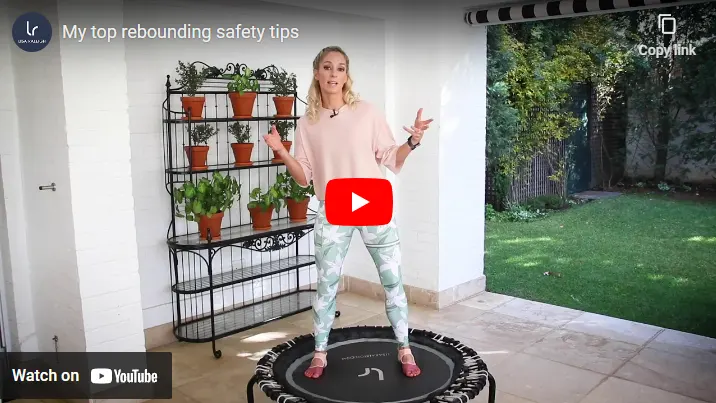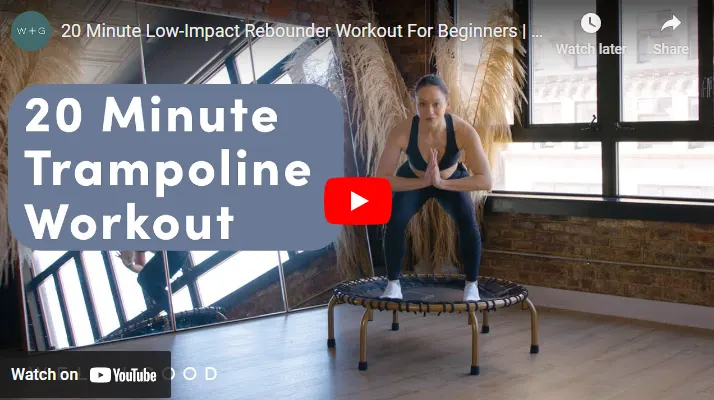Rebounding vs. Running: Full Breakdown Backed by Science
Disclaimer: This website exists thanks to you, the readers. When you buy through links on my site, I may earn an affiliate commission.
I come from a background of running, so I wasn't too excited about rebounding at the beginning. However, there is one big problem with running — the weather. I couldn't get enough workout hours with just running, especially in the winter. And I really, really didn't like the gym. Getting a treadmill didn't sound fun enough, so that's how I ended up with a rebounder.
Did I stop running? No. Do I love rebounding? Hell yeah!
But let's look at rebounding vs. running. Which workout is better? Surrounded by a lot of myths, rebounding has been growing in popularity. At the same time, good old jogging has been around for ages and is proven to be effective in staying fit and healthy.
So, is rebounding a good exercise? Is rebounding better than running? Or maybe you should choose the middle ground and go for jogging on a rebounder? 🤔😅
What is a rebounding workout?
If you’re new here and you’re wondering what rebounding is, that’s an easy one.
Simply said, it’s the process of bouncing on a rebounder mini trampoline (and a rebounder is different than a trampoline).
Rebounding has been gaining more and more popularity in recent years because of the plenty of benefits it offers. It’s a low-impact exercise, which makes it suitable for a wide range of people.
The great news is it’s very effective for weight loss. If you don't believe me, try this video or read my favorite rebounding before and after personal stories. I challenge you! 😋
A rebounder workout can be done in groups or in the comfort of your own home because it doesn’t require much space. Finally, it can be a lot of fun, especially if you add music or your favorite series to it!
I think I don’t need to explain what running is, so I’ll skip that one.
So, what makes rebounding a good workout?
A rebounder exercise can be done both at home and outside.
It’s actually a great option if you have children. You can get them to jump on a kid’s trampoline while you do your fitness routine on your rebounder. It’s a win-win-win because you’ll get your kid to spend some of their endless supply of energy, you’ll burn some of your own calories, and you’ll both have fun together.
Rebounding is also good for seniors and people with joint issues because it’s low-impact.
Now, let’s go over the most important benefits of rebounding.
Boosts heart health
Rebounding exercises are great for strengthening your heart, as they boost blood flow to your muscles. This kind of workout helps your blood circulate more efficiently in your veins. The bonus of rebounding over running is that it offers better results while putting less strain on your heart.
Engages your entire body
Mini-trampoline rebounding strengthens your whole body. At its core, bouncing creates gravitational resistance that the body responds to. That way, you include all your muscles during exercise, making them stronger and more flexible.
Additionally, there is some evidence that jumping on a mini trampoline may help the immune system by cleansing the body of toxins and by activating lymphatic circulation.
Perfect at-home workout for cold weather

Rebounder mini trampolines have one big advantage over running – not having to push yourself to go outside for a workout, especially in colder months. Rebounders are easy to store even in limited spaces, as most models fold up. That's one of the things to look at when buying a rebounder, by the way.
All you have to do is unfold it, pick your favorite tune, and start bouncing. You can bounce anytime, in any room, and even take your mini trampoline with you when you travel.
Easier on your joints than running
When it comes to rebounding vs. running and other high-impact exercises, such as HIIT, rebounding is gentler on your body.
While it has been proven that running does not cause arthritis, it can be hard on your joints. To put it in simple terms, rebounding creates a moment of weightlessness at the peak of each jump, followed by a landing with twice the gravitational force. So, when you consider rebounding vs. running, rebounding makes for a lower-impact exercise compared to running.
What makes running a great workout?
Running is a good workout that offers a wide range of health benefits for both body and mind. It's a wonderful way to strengthen your heart, burn calories, and build muscle, all while enjoying the release of feel-good endorphins.

To get started with running, you only need a pair of running shoes and a path to follow. You can easily tailor your running routine to your fitness level and goals. Although it’s not typically a social activity, you can join a running club or group to make this form of exercise even more fun.
Let’s go over the benefits of running.
Great for your heart
Running is an excellent cardiovascular exercise that strengthens the heart, improves blood circulation, and increases lung capacity, making it an effective way to maintain and improve heart health.
Shapes your booty and core
Running engages multiple muscle groups, particularly in the lower body, such as the quadriceps, hamstrings, calves, and glutes. It also builds strength in the core muscles, leading to increased overall strength and muscle tone.
Accessibility
It’s a relatively accessible form of exercise, as it can be done almost anywhere and requires minimal equipment (mainly a good pair of running shoes). This makes it an appealing option for people with limited time or resources.
Rebounding vs. running: Comparison chart
Here is a quick overview of running vs. rebounding.
Running | Rebounder | |
|---|---|---|
Efficiency | Mainly targets lower body muscles | Burns more calories and engages more muscle groups |
Warm-up Time | Requires proper warm-up and stretches | Minimal warm-up time, starts with gentle bounces |
Heart Fitness | Improves heart health but may strain it | Easier on the heart, allows for longer workouts |
Oxygen Intake | Increases heart rate and oxygen levels quickly, potentially leading to fatigue | Gradually improves oxygen intake, allows for longer workouts without exhaustion |
Impact on Joints | High-impact, increased risk of injury | Low-impact, minimal strain on joints |
Convenience | Depends on weather and space, may need a treadmill | Requires mini trampoline, can be done indoors or outdoors |
Joy Factor | Meditative, but may be repetitive for some | Versatile, social, and fun, can be done alone or with others |
Now let’s explore each of these rebounding vs. running factors in more detail.
Rebounding vs. running: Breakdown
Efficiency
When it comes to calories burned during rebounding vs. running, both can be effective choices. Studies indicate that rebounding may burn the same number of calories as running while also increasing aerobic fitness and being low-impact.
This could make rebounding a time-efficient option for those looking to maximize results with less effort. However, individual results may vary.
Another thing to keep in mind when it comes to efficiency is that rebounding provides a full-body workout, engaging various muscle groups. Running mainly targets lower body muscles.
Warm-up time
Like with any sport, do not skip the warm-up! This can lead to injuries. That being said, both running and rebounding require proper warm-up to prevent injuries. There are some differences in rebounding vs. running, though.
Rebounding requires minimal warm-up time, as you can start with gentle bounces and gradually increase intensity. Running generally needs a proper warm-up, including dynamic stretches, to prevent injury.
Heart fitness
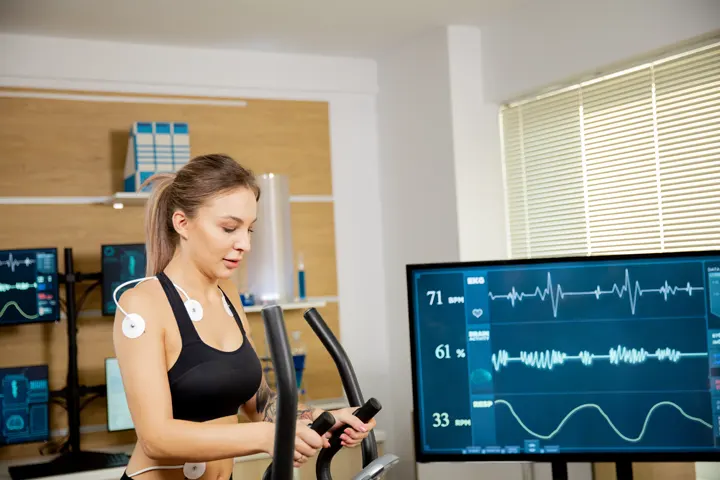
Rebounding increases blood flow to muscles and improves cardiovascular fitness with less strain on the heart. This is because it gradually increases your heart rate, potentially allowing for longer workouts without making you feel overwhelmed.
Running also improves heart health but may place more demand on your heart, depending on the intensity you choose. The downside is that it may cause quicker fatigue because it ups the heart rate abruptly. This makes some people give up at the very beginning.
Rebounding wins this one because it’s easier on your heart while also helping you keep it healthy.
Oxygen intake
Both running and rebounding are cardiovascular exercises, and they help improve your oxygen intake. Rebounding, though, does that slowly, so you can do longer workouts without feeling exhausted after. In fact, a recent study found that, in 6 weeks of training, the rebounding group experienced increased VO2 max (maximum oxygen intake) compared to the group that was running.
Running, on the other hand, can quickly increase heart rate and oxygen levels, leading to increased energy consumption and potential fatigue.
Impact on joints
Running is a high-impact exercise. It exerts pressure on your joints with a force which is up to 2.5 times your body weight. This is due to the fact that your feet hit a hard surface (the ground) over and over.
Rebounding is low-impact exercise that puts minimal strain on the joints. If you're just starting to develop an exercise routine, rebounding comes with a dramatically lower risk of injury compared to running.
Convenience
Rebounding requires a mini-trampoline and a pair of sneakers, allowing for flexible workout options. Running can be more involved, requiring appropriate running shoes for safety and comfort. Additionally, weather conditions and available space can factor into planning a run.
Rebounding can be done indoors or outdoors. A treadmill may be an alternative but could be costly and take up space. Both exercises have their pros and cons in terms of convenience.
Joy factor
Running and rebounding each offer unique experiences. While some may find running repetitive, others appreciate its meditative qualities.
Rebounding, on the other hand, provides various ways to exercise and can be done alone or with others, even in online sessions. It can be done at home or outdoors, offering flexibility in workout location.
For me, the fun aspect of jumping makes me stick to my workout routine. But ultimately, the joy factor depends on personal preferences and what works best for you.
My Top 3 Mini Rebounder Trampolines
Product | Our Rating | Verdict | Price |
|---|---|---|---|
The unique spring technology of the Cellerciser offers an adaptable rebounding experience that enhances your total body strength. | |||
This mini trampoline is a superb option if you are looking for a silent, steady, and high-capacity trampoline. It offers great value for its cost. | |||
The Darchen mini trampoline is an excellent purchase for those seeking a durable, quiet, and secure rebounder for frequent workouts. Great value for the price. |
Safety tips for rebounding
As with any type of sport, you have to consider your safety. It’s important to always make sure your mini trampoline is working properly. Place the rebounder on a flat, even surface, at a distance from walls and furniture.
Don’t forget to wear comfortable, well-fitting shoes with non-slip soles to provide support and stability during your workout.
You can use a rebounder with a stability bar or handle for added balance and support.
Always do a little warm-up, whether it’s rebounding or another form of sport. Notice how you’re feeling during your workout and stop, or at least slow down if you start feeling bad.
Throughout your workout, vary the exercises so you don’t strain the same muscles all the time.
Finally, don’t forget to cool down! Do some gentle stretches at the end to help your body recover and prevent injury.
If you follow these tips and you don't have any serious health issues, you should be safe from the negative side effects of rebounding.
FAQ
What makes rebounding well-suited to at-home fitness?
Mini-trampolines (rebounders) are very compact; many of the models are foldable, so you can just put them under the bed or lean them behind the door after your workout. Even when unfolded, they don’t take up as much space as a treadmill, so they are a good choice for apartments with small rooms and limited space.
Is it OK to rebound every day?
Rebounding is an easy type of exercise that engages the whole body, so it’s good for a wide range of individuals. However, the frequency of your workouts is an individual decision, depending on your overall health and daily activities. It’s best to look at different exercises for trampoline rebounders to find what works for you.
Is trampoline bouncing better cardio than running?
When comparing rebounding vs. rebounding, we should note that both are cardio exercises. The difference is that running ups your blood levels very quickly, whereas rebounding does that more slowly, which helps you do a longer workout and enjoy it more. Various studies show that jumping on a mini trampoline burns more calories in less amount of time than running.
How long should you jump on a trampoline for a workout?
To decide how long your sessions are going to be, you should observe your own body and health and take into account any discomfort that may occur.
As a general guideline, beginners may start with 10-15 minute sessions, while more experienced exercisers can aim for 20-30 minutes or even longer.
For a well-rounded rebounder workout, consider incorporating a mix of aerobic exercises, strength training, and balance exercises into your rebounding routine. You can gradually increase the duration and intensity of your workouts as your fitness level improves.
What are 10 minutes of rebounding equivalent to?
Studies show that rebounding is just as efficient as running, and it burns the same calories as running does. According to a study by The American Council on Exercise, men burn 11 calories per minute on average when jumping on a mini trampoline, and women burn 8.3 calories per minute. This means that, in 10 minutes, men will burn about 110 calories and women about 83 calories.
This is roughly equivalent to 10 minutes of running, 25 minutes of yoga, and 20 minutes of pilates.
Does rebounding help you feel better?
Rebounding might be a great way to enhance your mood. Like other forms of exercise, rebounding stimulates the release of endorphins, which are natural mood elevators. These "feel-good" hormones can help alleviate stress, anxiety, and mild depression.
Jumping on a mini trampoline allows you to create a varied workout routine without repetition, so it’s great for people who get bored easily.
What is a low-impact exercise?
Low-impact exercise refers to physical activities that place minimal stress on the joints, particularly the knees, hips, and ankles. These exercises are generally easier on the body than high-impact activities, which involve more forceful movements and can cause greater wear and tear on the joints.
Low-impact exercises are ideal for people who have joint issues, are recovering from an injury, are pregnant, or are new to exercise. They can still provide an effective workout, promoting cardiovascular health, muscle strength, flexibility, and balance. Examples of low-impact exercises include walking, swimming, cycling, yoga, pilates, and using an elliptical machine.
What is VO2 MAX?
VO2 max, or maximal oxygen uptake, is a measure of the maximum amount of oxygen an individual can utilize during intense or maximal exercise. It is a widely accepted indicator of a person's aerobic fitness and cardiovascular endurance. VO2 max is typically expressed in milliliters of oxygen per kilogram of body weight per minute (ml/kg/min).
The higher a person's VO2 max, the better their body can deliver and use oxygen during exercise, which translates to better overall endurance and aerobic performance. Factors such as genetics, age, gender, and training can influence a person's VO2 max, and regular aerobic exercise can help improve this value over time.
Conclusion
As with every physical activity, both rebounding and running have their undeniable benefits. And the choice depends on you – your physical background, your health condition, your preferences, and so on.
However, in recent years rebounding has caught on as it answers a lot of people’s needs for working out. It’s time-, space-, and money-saving. It’s good for people of all ages and fitness levels.
Rebounding has shown to be more effective than many other exercises because it enables you to burn more calories with less effort. And, last but not least, it’s fun!
References & Further Reading
- Burn 250+ Calories with These Fun Mini Trampoline Exercises for Weight Loss
- Is Rebounding Good For Weight Loss? | The Trampoline Review
- ☑️ Checklist: What to Look for When Buying a Rebounder
- [PDF] Is running associated with a lower risk of all-cause, cardiovascular and cancer mortality, and is the more the better?
- Exercise 101: Don't skip the warm-up or cool-down - Harvard Health
- Does Mini-Trampoline Training More Effective than Running on Body Weight, Body Fat, VO2 max and Vertical Jump in Young Men?
- High-impact vs Low-impact Exercise: Which is Suitable for You?
- Will continuing to run make my knees wear out faster? - Harvard Health
- Activity-generated endorphins: a review of their role in sports science. | Semantic Scholar

